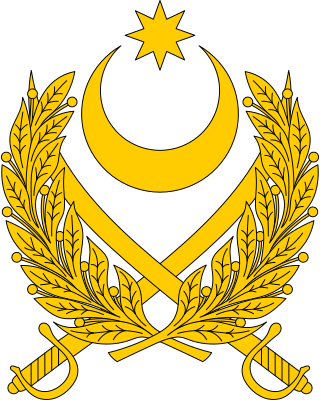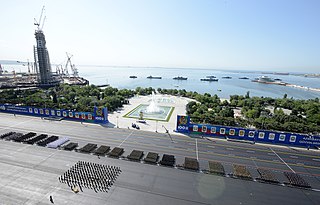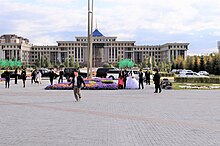
The Azerbaijani Armed Forces is the military of the Republic of Azerbaijan. It was re-established according to the country's Law of the Armed Forces on 9 October 1991. The original Azerbaijan Democratic Republic's armed forces were dissolved after Azerbaijan was absorbed into the Soviet Union as the Azerbaijan Soviet Socialist Republic from 28 April 1920. After the Soviet Union dissolved in 1991–92, Azerbaijan's armed forces were reformed based on Soviet bases and equipment left on Azerbaijani soil.

The Defence Forces of Georgia, or Georgian Defence Forces (GDF), are the combined military forces of Georgia, tasked with the defence of the nation's independence, sovereignty, and territorial integrity. They consist of the Land Force, Air Force, National Guard, and Special Operations Forces. The Defence Forces are under overall leadership of the Minister of Defence of Georgia and directly headed by the Chief of Defence Forces.

The Armed Forces of the Republic of Kazakhstan is the unified armed forces of Kazakhstan. It consists of three branches as well as four independent formations. The National Guard, Civil Defense, Border Service and the State Security Service serve as militarized affiliates of the armed forces. The national defence policy aims are based on the Constitution of Kazakhstan. They guarantee the preservation of the independence and sovereignty of the state and the integrity of its land area, territorial waters and airspace and its constitutional order. The armed forces of Kazakhstan act under the authority of the Kazakhstan Ministry of Defence.

The Korean People's Army encompasses the combined military forces of North Korea and the armed wing of the Workers' Party of Korea (WPK). The KPA consists of five branches: the Ground Force, the Naval Force, the Air Force, Strategic Force, and the Special Operation Force. It is commanded by the WPK Central Military Commission, which is chaired by the WPK general secretary, and the president of the State Affairs; both posts are currently headed by Kim Jong Un.

The Republic of Korea Armed Forces, also known as the ROK Armed Forces, are the armed forces of South Korea. The ROK Armed Forces is one of the largest and most powerful standing armed forces in the world with a reported personnel strength of 3,600,000 in 2022.

A commander-in-chief or supreme commander is the person who exercises supreme command and control over an armed force or a military branch. As a technical term, it refers to military competencies that reside in a country's executive leadership, a head of state, head of government, or other designated government official.

Military police (MP) are law enforcement agencies connected with, or part of, the military of a state. In wartime operations, the military police may support the main fighting force with force protection, convoy security, screening, rear reconnaissance, logistic traffic management, counterinsurgency, and detainee handling.

A military parade is a formation of soldiers whose movement is restricted by close-order manoeuvering known as drilling or marching. Large military parades are today held on major holidays and military events around the world. Massed parades may also hold a role for propaganda purposes, being used to exhibit the apparent military strength of a country.

An Armed Forces Day, alongside its branch-specific variants often referred to as Army or Soldier's Day, Navy or Sailor's Day, and Air Force or Aviator's Day, is a holiday dedicated to honoring the armed forces, or one of their branches, of a sovereign state, including their personnel, history, achievements, and perceived sacrifices. It's often patriotic or nationalistic in nature, carrying propaganda value outside of the conventional boundaries of a military's subculture and into the wider civilian society. Many nations around the world observe this day. It is usually distinct from a Veterans or Memorial Day.
An inspector general is an investigative official in a civil or military organization. The plural of the term is "inspectors general".

The Rear of the Armed Forces of the Russian Federation (RAF-RF), often referred to in English as the rear services, was an organization of support services for the Russian Armed Forces until 2010 when it was transformed into Logistical Support of the Russian Armed Forces.
Jiang, is a rank held by general officers in the armed forces of both the People's Republic of China and the Republic of China on Taiwan. The People's Liberation Army and the People's Armed Police use three levels at present while the Republic of China Armed Forces use four.

The Ministry of Defense was a government ministry in the Soviet Union, which supervised the Soviet Armed Forces. The first Minister of Defense was Nikolai Bulganin, starting 1953.

The Ministry of National Defense was the chief administrative arm of the East German National People's Army. The MND was modeled on the Ministry of Defense of the Soviet Union. The headquarters of the Ministry was in Strausberg near East Berlin. The Guard Regiment Hugo Eberlein provided security and guard services to the Ministry. The Ministry also had its own publishing house, Military publishing house of the German Democratic Republic.

The Volkspolizei served as the armed forces and the national police of the German Democratic Republic from 1946 to 1956. The Volkspolizei was responsible for most law enforcement in East Germany, but because of its organisation and structure it was also considered a paramilitary force. Unlike police forces in most countries, they were equipped with armored personnel carriers and artillery and trained as military units.

The Ministry of Defense of the Republic of Kazakhstan is a government agency of Kazakhstan which is the main executive body in implementing military policy. The Defense Minister of the Republic of Kazakhstan is the head of the Ministry of Defense, whose duties are to exercise the administrative leadership of the Armed Forces of the Republic of Kazakhstan.

The Ministry of Defense of Georgia is the Georgian government ministry in charge of the Defense Forces of Georgia and regulating activities in defence of the country from external threats, preserving territorial integrity and waging wars on behalf of Georgia. The Minister of Defence is appointed and removed from the post by the Prime Minister of Georgia. The ministry is currently headed by Irakli Chikovani.

The Armed Forces of the Republic of Poland, Also called the Polish Armed Forces And popularly called Wojsko Polskie in Poland are the national armed forces of the Republic of Poland. The name has been used since the early 19th century, but can also be applied to earlier periods. The Polish Legions and the Blue Army, composed of Polish volunteers from America and those who switched sides from the Central Powers, were formed during World War I. In the war's aftermath, the Polish Army was reformed from the remnants of the partitioning powers' forces and expanded significantly during the Polish–Soviet War of 1920.

The Armed Forces of Ukraine are the military forces of Ukraine. All military and security forces, including the Armed Forces, are under the command of the President of Ukraine and subject to oversight by a permanent Verkhovna Rada parliamentary commission. They trace their lineage to 1917, while the modern armed forces were formed after Ukrainian independence in 1991.

The Bulgarian People's Army was the army of the People's Republic of Bulgaria. It comprised the Bulgarian Land Forces, Air Force and Air Defence, Navy and supporting arms. Bulgaria was one of the signatories of the Warsaw Pact. Along with troops from other Warsaw Pact countries, the BNA participated in the Warsaw Pact invasion of Czechoslovakia in 1968. However, other than this, the BNA did not see any combat during its existence. The Bulgarian People's Army was dissolved along with the People's Republic of Bulgaria in 1990 and was succeeded by the Bulgarian Armed Forces.


















